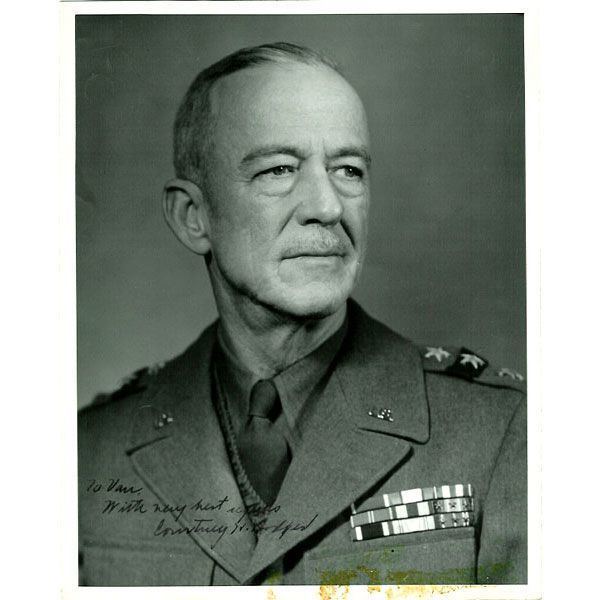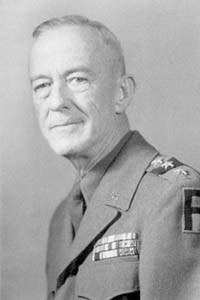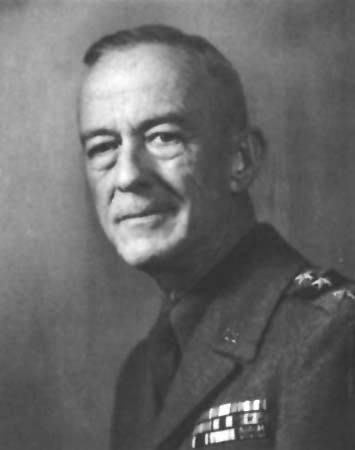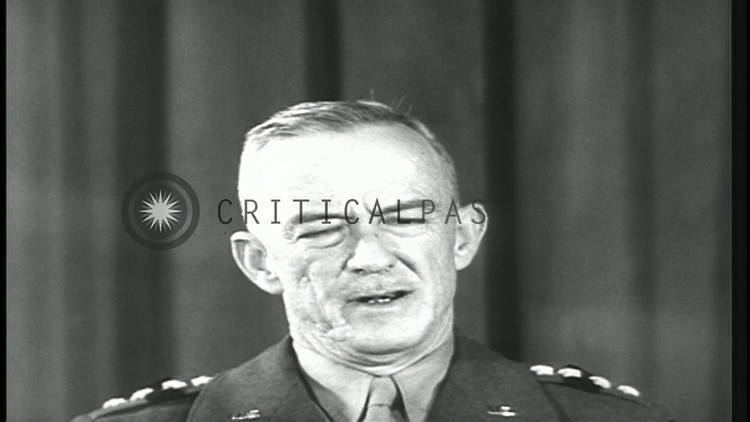Birth name Courtney Hicks Hodges Name Courtney Hodges | Years of service 1906 – 1949 | |
 | ||
Allegiance United States of America Battles/wars World War ISecond Battle of the MarneWorld War IIBattle of NormandyBattle of Hurtgen ForestBattle of the Bulge Battles and wars Second Battle of the Marne, World War II, Operation Overlord, Battle of Hurtgen Forest Similar People William Hood Simpson, Leonard T Gerow, Omar Bradley, J Lawton Collins, Walter Model | ||
Service/branch United States Army | ||
General courtney hodges u s first army wwii europe
General Courtney Hicks Hodges (January 5, 1887 – January 16, 1966) was a decorated senior officer of the United States Army, most prominent for his role in World War II, in which he commanded the U.S. First Army in the Western Europe Campaign. In his career Hodges was a notable "mustang" officer, rising from private to general.
Contents
- General courtney hodges u s first army wwii europe
- Lieutenant general courtney hodges and lieutenant general miles dempsey meet at m hd stock footage
- Early life and military career
- World War I and postwar years
- World War II
- Post war life
- Legacy
- References

Lieutenant general courtney hodges and lieutenant general miles dempsey meet at m hd stock footage
Early life and military career

Hodges was born in Perry, Georgia where his father published a small-town newspaper. He attended North Georgia Agricultural College (now known as the University of North Georgia) before transferring to West Point. He would have graduated with the Class of 1909, but he dropped out after just one year because of poor test scores ("found deficient" in mathematics).

In 1906 Hodges enlisted in the United States Army as a private and was assigned to Company L of the 17th Infantry. He quickly rose to the rank of sergeant and he received his commission as an 2nd lieutenant in 1909 after performing well on a competitive examination. In his early career he served with future Army Chief of Staff George Marshall in the Philippines and future General George Patton in Mexico.
World War I and postwar years

He served with 6th Infantry Regiment, 5th Division during World War I. Hodges rose to lieutenant colonel and commander of a battalion in the 6th Infantry, and earned the Distinguished Service Cross for heroism while leading an attack across the Marne River during the closing days of the war. After the war he was sufficiently well thought of that he became an instructor at West Point, even though he was not a West Point graduate.
He graduated from the Command and General Staff College in 1925, and the Army War College in 1934.
Hodges was a member of the Infantry Board at Fort Benning from 1929 to 1933. In 1938, he became an assistant commandant of the United States Army Infantry School, and in 1941, he became commandant.
World War II
In May 1941, during World War II, he was promoted to major general, and he was given various assignments, including Chief of Infantry, until he finally received a command of the X Corps, which was stationed stateside, in 1942. In 1943, while commanding X Corps and then the Third Army, he was sent to England, where he served under the then commander of the First Army, Lieutenant General Omar Bradley.
During Operation Overlord in June and July 1944, Hodges served under Bradley as the deputy commander of the First Army. In August 1944, Hodges succeeded Bradley as the commander of First Army, taking over when Bradley moved up to command the 12th Army Group. Hodges served under the command of Bradley and General Dwight D. Eisenhower until Nazi Germany's surrender in May 1945.
Hodges's troops were the first ones to reach and liberate the French capital of Paris in large numbers, and then he led them through France, Belgium, and Luxembourg on their way to Germany.
During the failed British attack on Arnhem, Operation Market Garden, supply priority was given to the Anglo-Canadian 21st Army Group, and the U.S. First Army was diverted to the north of the Ardennes to stage limited attacks to draw German defenders south, away from the target sites.
Hodges's troops had a major role in blunting the Wehrmacht's major counteroffensive in the Ardennes: the Battle of the Bulge. When the German advance cut the First Army off from the 12th Army Group and Bradley, for several weeks his First Army was placed under the temporary command of the Anglo-Canadian 21st Army Group, under Field Marshal Bernard Montgomery, along with U.S. Ninth Army.
Before, during, and after the Battle of the Bulge, the First Army fought the Germans in the Battle of Aachen, and the parallel 5-month long Battle of Hurtgen Forest to the south of Aachen, as part of the main US effort to breach the Siegfried Line and advance through Germany to the Rur River. The city of Aachen eventually fell on 22 October, but the German counter-offensive and the Battle of the Bulge took place before the other objectives could be completed. Once the US had won the Battle of the Bulge, the Hürtgen Forest was taken and on 10 February the Rur Dam was finally captured. The over-all cost of the Siegfried Line Campaign in American personnel was close to 140,000.
The 9th Armored Division of the First Army captured the Ludendorff Bridge at Remagen on 7 March 1945. The First Army was the first enemy of Germany to cross the Rhine since the Napoleonic Wars. By the time the bridge collapsed after 10 days, the First Army had built two heavy duty bridges across the Rhine and established a bridgehead 40 kilometers (25 mi) long, extending from Bonn in the north almost to Koblentz in the south, and 10 to 15 kilometers (6.2 to 9.3 mi) deep, occupied by five U.S. divisions. They advanced slowly, waiting for Montgomery and the 21st Army Group to launch Operation Plunder attack across the Rhine on 23 March.
A month later, Hodges's troops of the First Army met elements of the Soviet Red Army near Torgau on the Elbe River. Hodges was promoted to the rank of four-star general on April 15, 1945. He was only the second soldier in the history of the U.S. Army to make his way from private to four-star general, the other being Walter Krueger who served in the Southwest Pacific Theater. Eisenhower referred to Hodges as the “spearhead and the scintillating star” of the US advance into Germany, and sought to ensure that Hodges was properly recognised for his achievements despite “being seemingly overlooked by the headline writers.”
After the end of World War II in Europe on May 7, 1945, Hodges and the First Army were ordered to prepare to be sent the Pacific Theater for the proposed invasion of Japan in late 1945 to March 1946. However, that move became unnecessary when two atomic bombs were dropped on the Japanese cities of Hiroshima and Nagasaki and Emperor Hirohito ordered the defeated Japanese Empire to surrender immediately. The official surrender documents were signed in Tokyo Bay on September 2, 1945.
General Hodges was one of the very few individuals present at the surrenders of both Nazi Germany in Rheims, France and of the Japanese Empire at Tokyo Bay.
Post-war life
After World War II, Hodges continued command of First Army at Fort Jay at Governors Island, New York until his retirement in March 1949.
Hodges died in San Antonio, Texas in 1966. He was buried at Arlington National Cemetery, Section 2, Grave 890-A
Legacy
In Perry, Georgia, the State Route 7 Spur, a former section of U.S. Route 41/State Route 7, was named General Courtney Hodges Boulevard.
